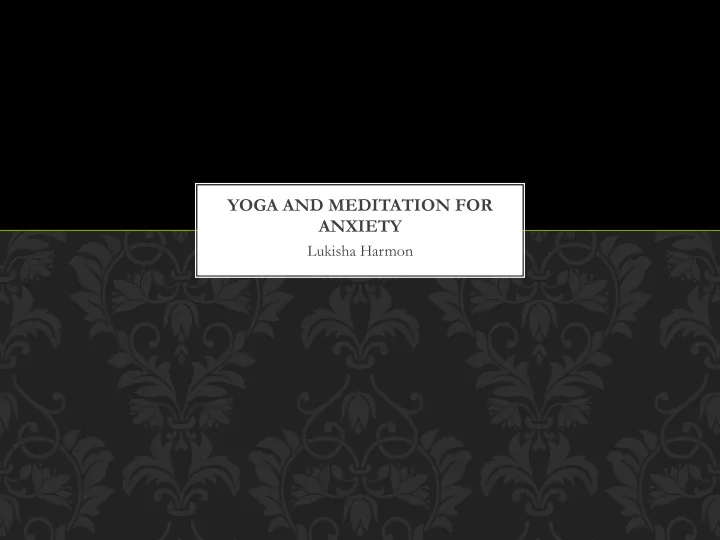

YOGA AND MEDITATION FOR ANXIETY Lukisha Harmon
PURPOSE • Designed for individuals who have extreme anxiety • Designed to help clients manage their anxiety using yoga and meditation • Anxiety disorders are the most common mental illness in the U.S.
INTERVENTION • Focus on teaching relaxation, meditation, and deep breathing • Teach deep breathing techniques that can be used to help reduce anxiety in stressful times • Goal is for clients to be able to successfully reduce their own anxiety
STAFF • 2 staff members required • Both staff members need to be certified yoga instructors • The client staff ratio will be 2:6 • During some groups clients will be split between the two staff members • The reason for having 2 staff members is so that one can lead the group and one can help if there are any struggling clients
GROUP SIZE • There will be a total of 8 people in the group (2 staff members and 6 clients) • There can be no more or no less than 6 clients in group • This is so that we can keep the group even and conducive to our plans
DURATION • Over the course of 2 months • Once a week • Each session will be 2 hours long • 1 hour will be dedicated to yoga and 1 dedicated to meditation
METHODS • Each week the warm-up activity will include a check-in. We will talk about how each person is feeling before we start the actual group. -Overall, how connected are you feeling today? -On a scale of 1-10, how anxious are you feeling in this moment? -What are you hoping to get from group today? • The actual activity will be focused on different techniques that can be used in yoga to reduce anxiety. -Bridge -Tree Pose -Cat/cow -Pigeon Pose -Extended triangle -Spinal twist Forward fold -Childs pose
YOGA POSES
METHODS • The end of the activity will be a follow-up. This will be to determine if any stress levels were decreased as a result of yoga -On a scale of 1-10, after the group how anxious are you felling? -Did this group help you relax in any way? -Was there anything that you feel was not addressed in the group? • The transition into meditation from yoga will be to have the client just relax on their mat. This intervention will be all about relaxation. • They client will be learning to sit with the feelings of anxiety and then decide what they should do. This will just give them the time and space to think. They will be able to focus in on what is making them anxious and use some of their new calming techniques.
METHODS • Some questions will be asked to help facilitate understanding. There will also be some prompting. -What are you currently feeling? -Where are you feeling it? -Just notice your surrounding -Notice the sounds, the noises, and the contact of your body to the mat -You don’t have to change how you’re feeling, just notice it • The closing of this intervention will be another follow-up. This is just one last check-in to make sure that the client got what they needed from the session.
METHODS • Here is an example of a few follow-up questions that might be asked. -Is there anything that you need from us as the group is coming to an end? -Was this group beneficial for you? Why or why not? -Is there anything that can be done different to help meet your needs?
CLIENT OUTCOMES • client should be able to reduce their anxiety on their own using the functional skills that were learned during the course of the intervention • client will have an increased self-awareness • client should have better insight on what makes them anxious and in what situations they get the most anxious • client will know calming breathing techniques that will help with the reduction of anxiety • client will have an increased quality of life after the intervention
REFERENCES Li, A. W., & Goldsmith, C. W. (2012, March 01). The effects of yoga on anxiety and stress. Alternative Medicine Review, 17(1). Weaver, L. L., & Darragh, A. R. (2016, November/December). Systematic review of yoga interventions for anxiety reduction among children and adolescents. Journal of Occupational Therapy, 69(6). doi:10.5014/ajot.2015.020115 Shaikh, S., & Kumar, S. (2013). A comparative study between relaxation technique versus 12 moves of yoga on anxiety in young adults - A randomized clinical trial. Indian Journal of Physiotherapy & Occupational Therapy, 7(2), 202-206. doi:10.5958/j.0973-5674.7.2.042 Doria, S., de Vuono, A., Sanlorenzo, R., Irtelli, F., & Mencacci, C. (2015). Anti-anxiety efficacy of Sudarshan Kriya Yoga in general anxiety disorder: A multicomponent, yoga based, breath intervention program for patients suffering from generalized anxiety disorder with or without comorbidities. Journal Of Affective Disorders, 184310-317. doi: 10.1016/j.jad.2015.06.011 Woodyard, C. (2011). Exploring the therapeutic effects of yoga and its ability to increase quality of life. International Journal of Yoga, 4(2), 49-54. doi:10.4103/0973-6131.85485 Zeidan, F., Martucci, K. T., Kraft, R. A., McHaffie, J. G., & Coghill, R. C. (2013, April 24). Neural correlates of mindfulness meditation-related anxiety relief. Oxford Journals. doi: 10.1093/scan/nst041
Recommend
More recommend